 |
 |
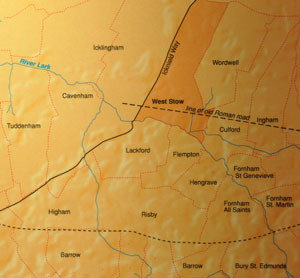
|
Mills along the River Lark survived into the 20th century. However, we must not think that the mills which survived were very much like their predecessors in medieval times. The first watermills used wood exclusively, while the Victorians were routinely producing cast iron water wheels and steel gears. Steam power had been added to augment water power in some places, while others were to include diesel engines and steel rollers to replace millstones, if they warranted the investment, or had sufficient faith in the future.
Water mills also tended to be handed down within a family, so the miller might change over the years, but the name stay the same.
Facts or suppositions about each mill will be included below, and the reader should be aware that in a time span of up to a thousand years, mill structures and methods will have changed, and even the site of the individual mill may have shifted somewhat.
|
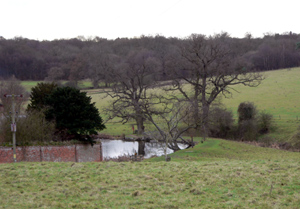 |
Ickworth Mill This mill is recorded in the Domesday Book, and dates back to before 1066. The village of Ickworth was moved wholesale into Horringer, when the Ickworth estate was emparked. Only a few indications remain of the village, including the church by the lake in the park. The River Linnet has been dammed to form the ornamental canal or lake in about 1717, from where it now flows down to Bury St Edmunds, through the Butts and joins the River lark just south of the Abbey gardens. Edward Martin has pointed out that a survey of 1664 referred to this area as Pond Close. This could indicate the existence of a pre-existing pond, which might have been associated with a watermill.
The mill may well have sat near to where the lower end of the lake is dammed today, as shown in this picture.
This mill is recorded in the Domesday Book, and dates back to before 1066. By 1280 it had been replaced by a windmill.
|
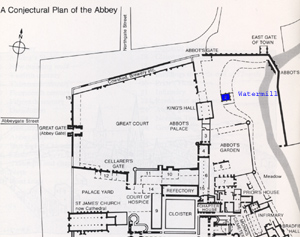 |
The Abbots Mill, within the Abbey precincts In the Domesday Book, the town of St Edmunds had two mills in 1086, but their locations are unknown. Later we know about the Abbot's Mill and a mill at Babwell. Abbot Anselm is recorded in a charter, quoted by Antonia Gransden, as building a mill in the abbot's court. Anselm ruled the abbey from 1121 to 1148. The location of this mill is shown on the attached plan, marked in blue. It stood between the Dovecote and the Abbots Bridge, on a stream that is no longer in existence.
|
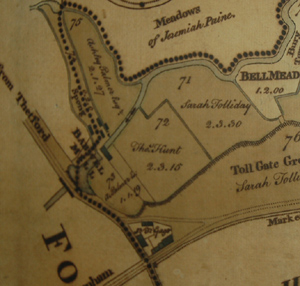 |
The Babwell Mill Jocelin of Brackland recorded the trouble caused when Abbot Samson constructed a new watermill at Babwell. Samson "so raised the level of the fishpond at Babwell for his new mill that, owing to the holding back of the water, there is no man, rich or poor, having land on the riverside between Tollgate and Eastgate, but that has lost his garden and orchards." This dam stretched from the mill to the "Tollcote", which was where the abbey collected tolls from merchants entering the banleuca's boundary. It is somewhat unclear whether this tollcote controlled both road and river entrances, or just one or the other. In 1924 an excavation took place near the Tollgate public house to explore the site to discover the mill. The 1700 Lark navigation work only reached as far as the old maltings buildings on Mildenhall Road, so it is unlikely that the site was disturbed at this time. However the renewed work in the 1890s designed to extend the navigation up to St Saviours, caused a considerable re-alignment and dredging of the river. This has made it difficult to interpret the site. Warren's map of Bury St Edmunds of 1791 shows the Babwell mill located on the River Lark at the Borough boundary at the site of the Tollgate Inn. It is fed by the River and by the Mermaid Springs and Babwell Fen, both of these latter features have been obliterated by the Sugar Beet factory lagoons.
In 1989 to 1994 excavations took place on the site of the proposed Tesco supermarket, behind St Saviour's Hospital ruins. Evidence of a mill pond was also found here, and it is unclear if this was part of a different mill to that described as Babwell above.
This mill is recorded in the Domesday Book, and dates back to before 1066.
The 12th century Abbot Samson called this mill Ailmer's Mill (Ailmeres melne). In 1186-1200 it was leased to Ailmer in heredity for 30 shillings annually, payable at Fornham Hall in four parts. The price had increased from 26s.
In 1822 John Gage reckoned there were four ancient mills in Fornham All Saints, but he failed to specify if these were watermills or windmills. He named them as |
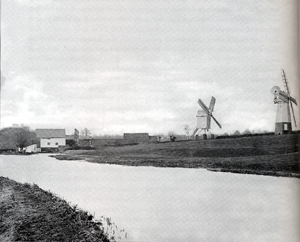 |
Fornham St Martin Mill It is unclear whether the watermill which existed on the Fornham St Martin side of the River Lark in the 19th century was the same mill as referred to in Domesday Book. The view here is apparently from about 1870, and was published by Norman Scarfe in his "Suffolk Landscape". These three mills can also be seen on the OS map of 1884. In 1894 this mill was run by a Mr Wicks. Roy Silverlock reported that this mill had three pairs of stones, and a low breast-shot wheel of 14 feet by 5 feet. It worked in company with the two windmills. It probably stopped working before World War II, but the buildings had some use as farm buildings after that. It was derelict by the 1960s and was demolished as part of the Golf Club development at Fornham. A footbridge marks the spot where the mill stood, and the millpool is still visible on the river, together with brickwork for the mill's tail-race. |
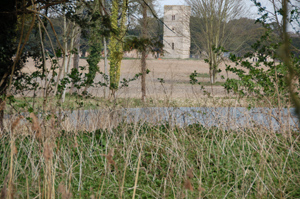 |
Fornham St Genevieve Mills Domesday Book (paragraph 14.53) records that there were 'always' three mills at Fornham St Genevieve in the hands of St Edmunds. This means at least back to the "tempus rex edwardii", or the time of King Edward the Confessor, 1042-1066. In 1186/90 the mill called Salmondesforde at Fornham St Genevieve was leased by Abbot Samson to William of the Granary.
In 1560 a schedule of holdings of the late Sir Thomas Kytson, included the following: In 1817 an Act of Parliament placed the Lark navigation under 80 Commissioners. This Act also consolidated into itself all the provisions of the 1699 River Lark Act, and added several new clauses, some of which were to protect the rights of millers along the river. One provision was specifically in favour of the Duke of Norfolk, who owned the Fornham St Genevieve estate. The ancient site of the Fornham St Genevieve Mill, owned by the Duke of Norfolk, was to continue to enjoy its traditional privileges. The Act continued, "if the same ancient mill had been now existing and in use." The Duke wanted to retain his miller's privileges over the river in spite of the fact that the mill no longer existed. In 1822 John Gage recorded that "Here, (FSG) the prior had a villa and here was a water corn-mill, known in early deeds by the name of the Abbot's Mill." Today there is no trace of this mill, or the others, as the village and its mill(s) was swept away in the 18th century as part of the creation of Fornham Park. This view shows the ruined church across the ornamental lake, viewed from the bank of the River Lark. The former millpond and millstream were dammed and converted into the ornamental canal or lake alongside the River Lark when the park was landscaped in the 18th century. Salmondesforde mill also seems to have become known as Hengrave Mill in later years, as shown below. |
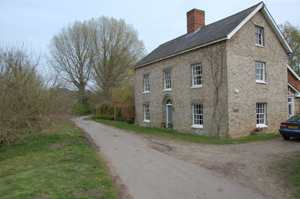 |
Hengrave Mill This mill is recorded in the Domesday Book, and dates back to before 1066. A deed found by the Ingham Local History Society for their book on the Culford Estate, dates to 1521, and refers to a parcel of land between Hengrave Mill and "Chimneymylle".
In 1560 a schedule of holdings of the late Sir Thomas Kytson, included the following: Household Accounts from Thomas Kytson's time at Hengrave Hall were published by John Gage in 1822. One entry for November, 1572, reads as follows:- "For scouring liiij (54) roddes of ditching work, at the mill, at ijd (2 old pennies) the rodde, ixs (9 shillings)". Roy Silverlock quotes a map from 1588, in which this mill is labelled Salmysford Mill. He also notes a map of 1769 in which the mill is shown half in the parish of Hengrave and half in Fornham St Genevieve. In 1822 John Gage wrote his History of Hengrave. In this work he referred to Hengrave mill as being called Salmondeford, and recorded that it passed to Hengrave Manor "shortly after" the Pope confirmed the abbot's grant to William of the Granary. This illustrates the difficulty of identifying precisely where these original mills were located. The most recent Hengrave Mill sits away from the River Lark, and is fed by a long leet or stream from the river. A mill pond was formed above the mill, and the mill pool below it then returns the water to the Lark some way down stream. It is very likely that the water management system was greatly altered by the various canal dredging operations that took place on the Lark Navigation. These were in three main phases. The first was from 1700-1715, when the Navigation was first opened. Then followed the improvements by Thomas Gery Cullum in the years from 1810 to 1845, and finally the short lived but major works undertaken in the 1890s. Silverlock asserts that this mill was built over the original course of the river, and that the current river was a completely new cut along this length dating to 1700 to 1715. The last mill was a timber building demolished in 1932, and was located on the north east side of the surviving mill house. The house is now called Mill Farm. The mill tail race is now a shadow of its former self, but forms a very pretty part of the garden with the old road bridge over it. Mill Road, Hengrave no longer allows vehicular access to Culford and West Stow, the bridge having been closed to all but foot traffic. |
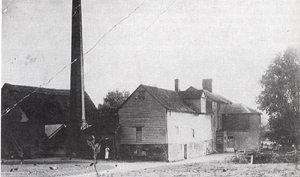 |
Chimney Mills, West Stow/Culford The Domesday Book recorded two mills at West Stow, according to Gransden. My copy does not confirm this. However, one of Abbot Samson's leases dated between 1200 and 1211, refers to "our two mills (at West Stow) which pertain to the scriptorium of the church of St Edmund". Both mills were leased for life to Gervase for 60 shillings. However, upon his death the leases reverted to the abbey and could not be inherited by his sons. Gervase was the son of H one of the abbey's moneyers, responsible for minting the silver pennies used as currency at the time. Also, by 1540, the sales particulars of West Stow manor included a water mill and a fulling mill. At this date the manor was purchased by Sir John Crofts from the Crown as part of the Dissolution of St Edmund's Abbey. Another deed found by the Ingham Local History Society for their book on the Culford Estate, dates to 1521, and refers to a parcel of land between Hengrave Mill and "Chimneymylle". Also found was a lease of 1661, when it was called 'Chimney Mill alias Hurdles Mill.' In 1700, the proposed works to make the Lark navigable were a threat to existing users of the river, in particular, the water millers. One way that the navigation owner, Henry Ashley dealt with this issue, was to take the problem over to himself. In October of 1700 he leased the Chimney Mills from Lord Cadogan for 25 years. In fact, this mill would remain in the hands of the River Lark Commissioners for the next one hundred years. The miller at the time seems to have been Samuel King, and he stayed on until his death. His widow finally gave up the mill in 1722. The deeds from 1700 referred to, "that water mill or mills, commonly called or known by the name Chimney alias Hardles mills..." Roy Silverlock found that by 1840 the mill had been extended to three stories, a large flint wing had been added and the wooden water wheel had been replaced by a steel one. The 75 foot chimney stack arrived along with a steam engine around this time. The name Chimney Mill is much older than the Chimney, and relates to the oddly shaped plot of land on which the original mill stood. Being long and thin, the site was a "chimney" of land. In 1851 the miller was Mr Day and who employed three other millers, two labourers and one boy. By 1861, the workforce was enlarged to five millers. The building spanned the river, and had three pairs of stones. From 1878 to 1892 the miller here was Abraham Bell, a baker from Bury St Edmunds. Some time around 1890 to 1900, the Chimney Mills water wheel had been replaced with a 20 foot diameter steel wheel made by Woods and Cocksedge of Stowmarket. At that time the mill had 3 pairs of stones for wheat and one pair for barley. In March 1894, Mr Bell was still at Chimney Mills, according to William Howlett's account in the Bury Free Press. For many years the area around Chimney Mills at West Stow had been "extra parochial". Some 7.5 acres were included in none of the surrounding parishes of Culford, Hengrave and West Stow. After an enquiry held in 1896, Chimney Mills was annexed to Culford in October, 1897, following the wishes of Lord Cadogan. The watermill at Chimney Mill closed down in 1916. It would be demolished in 1932. However, the bakery continued after 1916, and the chimney was used by the bread ovens. Harry Bell took over the bakery by 1929, but this seems to have closed along with the 1932 demolitions. The chimney still survives, along with the mill house and outbuildings. |
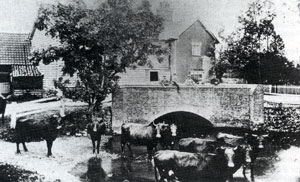 |
Flempton Mill
Flempton Mill, like Hengrave Mill, sits away from the River Lark, and is fed by a long leet or stream from the river. A mill pond was formed above the mill, and the mill pool below it then returns the water to the Lark some way down stream. It is very likely that the water management system was greatly altered by the various canal dredging operations that took place on the Lark Navigation. These were in three main phases. The first was from 1700-1715, when the Navigation was first opened. Then followed the improvements by Thomas Gery Cullum in the years from 1810 to 1845, and finally the short lived but major works undertaken in the 1890s. |
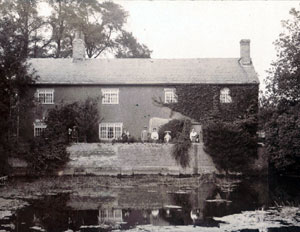 |
This mill is recorded in the Domesday Book, and dates back to before 1066. In 1625 it was leased to John Briant for 21 years by Lady Elizabeth Kytson of Hengrave Hall. At that time it had one pair of stones. In 1893 the mill had passed to Mr Barbrook, junior, who had taken over from his father in the last couple of years. William Howlett described him as an industrious young man, but by 1894 he was facing stiff competition from newer technology. Mr Barbrook apparently remarked that these roller mills take a lot of beating.
The first picture shown here is from the Suffolk Record Office, and is labelled as "Flempton Mill in 1909". However, the buildings appear different from those shown in the other two pictures, and this may, in fact, be Hengrave Mill. The second picture is taken from a postcard posted in 1906, courtesy of Gerald Brown's collection. |
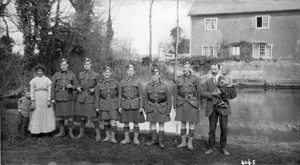 |
This picture shows six soldiers of the Argyll and Sutherland Highlanders, with the miller and his family in front of Flempton Mill, Suffolk in 1917. The mill was demolished in the 1930s. The mill house was then extended over the site, and over the mill race. The house still stands and the tail race may be seen emerging from the bridge over the road. |
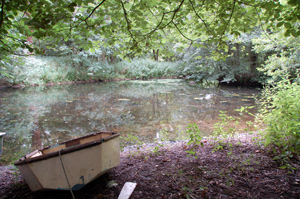 |
Wordwell Mill This mill is recorded in the Domesday Book, and dates back to before 1086, but was not known before 1066. Wordwell at this time was in the hands of the Abbey of St Edmund. There is a Land Grant (Sawyer Reference S 1225, and Thomson ref 112), dated to around 1040, whereby one Thurkytel granted to the Abbey of St Edmund lands at Culford, (Culeforde), Wordwell, (Wridewelle), and Ixworth, (Gyxeword).
Its location is currently unclear, but the Wordwell Stream is fed by this pond adjacent to Wordwell Hall. The stream then runs down to West Stow, where it joins the Culford Stream, and thence into the River Lark.
No mills were recorded here in Domesday, but by 1279 a watermill was recorded by the commission of 1279-1280 in the hundred rolls for West Suffolk.
Culford Mill may have been located on the River Lark, as the parish boundary extends to the river. However, the village was within what is now Culford park, and the mill may have been located nearby to where the current ornamental park lake flows into the Culford Stream.
It is possible that Chimney Mill may also have been reckoned to be located in Culford, although it was extra-parochial for many years.
|
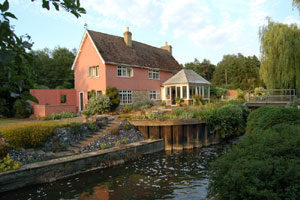 |
Fullers Mill, West Stow The Domesday Book recorded two mills at West Stow, according to Gransden. My copy does not confirm this. However, one of Abbot Samson's leases dated between 1200 and 1211, refers to "our two mills (at West Stow) which pertain to the scriptorium of the church of St Edmund". Also, by 1540, the sales particulars of West Stow manor included a water mill and a fulling mill. At this date the manor was purchased by Sir John Crofts. Fulling was a process carried out on woollen cloth to clean and thicken it. The cloth had to be soaked in a bath of water and fuller's earth or urine, to first remove the grease. It was then beaten with mallets and repeatedly smoothed. Since the 13th century, the beating had been carried out by water power raising and releasing the heavy wooden mallets. It was then washed in clear water to remove the effects of the process. The Ingham Local History Group found a lease dated 1458 for Charmans Farm at Risby. The lease excluded "the fulling mill at West Stow called Formylle...". Similarly in 1461 a deed in the Suffolk Record Office described Thomas Grought as a fuller of West Stow. In 1823 it was a "neat cottage" occupied by Mrs Palmer. In 1841 the 75 year old John Johnson, still referred to as a miller, lived there with a servant. The fullers mill was thought to be located on the opposite side of the river to the cottage. It stood on a narrow bank above its millpond. The pond is still visible as part of the gardens. The cottage dated originally to the 1650s, and has largely been replaced by the modern house, with a magnificent garden open to the public every month during the season. It is home to Bernard Tickner, the garden's creator, but the greater part of the gardens are now managed by the Fullers Mill Trust. The Fullers Mill Trust website is at www.fullersmillgarden.org.uk
The Domesday Book recorded two mills at Lackford.
|
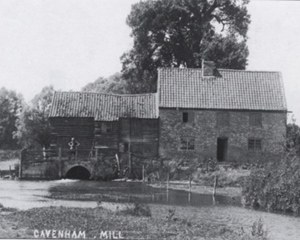 |
Cavenham Mill This mill was on the Cavenham Stream or Brook, just off a minor road between Cavenham and Icklingham. In this picture Pat O'Brian reported that it had an undershot wheel of 12 feet by 3 feet. It had direct drive from the 7ft 6in diameter pit wheel. It had only one pair of stones. Roy Silverlock reported that this mill had an all-iron breast shot wheel, 12 feet in diameter, which was enclosed on its eastern end. Both agree that the mill was fed directly from the stream. The mill was derelict by the 1960s, and a house was built on the site. No trace of the mill building now remains, although the name 'Mill Heath' remains to mark its former presence. |
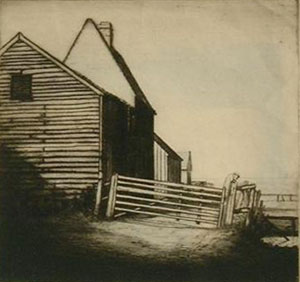 |
This drypoint by Alfred Blundell appeared on EBay in 2010, entitled Cavenham Mill. The view is rather odd, but adds something to our knowledge of this mill. Unfortunately the date is currently unknown. I believe that another view of this mill was drawn by Blundell, and possibly the miller's portrait was made in drypoint as well. |
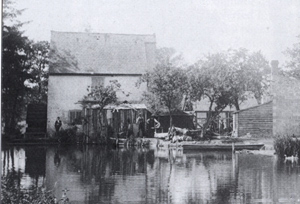 |
Icklingham Mills One mill at Icklingham is recorded in the Domesday Book as belonging to St Edmund's abbey, and dates back to before 1066. However, there were other lords with rights within Icklingham in 1086, and these also included mills. The King held St James in Icklingham as part of the manor of Mildenhall, with its mill. In 1190 Abbot Samson bought this manor from King Richard. Richard Peverel and Eudo, son of Spirwic, both held small manors here, with a mill each. One of these was also acquired by St Edmunds, and became called the Sacristan's Manor or Sexton's Manor. The other passed into the Berners family, who built All Saints church on it in the 12th century. Thus Domesday records a total of four mills in Icklingham, under four different land lords. The names of these mills sometimes appeared in leases and legal documents a century or more after Domesday.
By 1716 this mill, like Chimney Mill, was taken over by Henry Ashley of the River Lark Navigation Company. This would ensure that mill and navigation would run in harmony, avoiding disputes over water rights etc.. In August 1735 John Kirby published his book called "The Suffolk Traveller". He noted that the River Lark was canalised, and that goods were not just delivered to Bury St Edmunds, but were dropped off at villages along the river as required. The miller at Icklingham was being paid 40/- a year in 1735 to look after the Temple Staunch, and £5 a year for collecting the tolls payable on deliveries to Icklingham. The 18th century mill, predecessor to Marston's, burnt down in the early 19th century. It was replaced by another one on a slightly different part of the river. By 1890 the mill had a waterwheel and a turbine. The waterwheel was 18 feet by 5 feet, and appears to be undershot from the picture here. The miller at this time was aged 91, and called Mr Benstead. Roy Silverlock noted that at least part of its work at this time was grinding the gravel that was extracted at Icklingham for road works. Barges took this back to Mildenhall and beyond. After Mr Benstead's death the mill was bought by Parkers of Mildenhall.
|
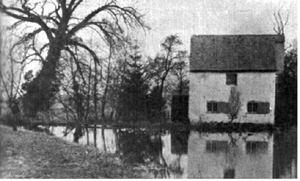 |
In April 1893, Parker's watermill at Icklingham was converted to use electric lighting. A generator was run off the waterwheel. It was the first flour mill in Suffolk to be lit by electricity. The River Lark Navigation and all its rights were finally sold to Parker Brothers of Mildenhall, on July 30th, 1902. This allowed them to use the river to service this mill, as well as their one at Barton Mills. By 1910 the mill was virtually derelict.
In 1910 the mill was taken over by Carlos Marston, who purchased it in 1921. It has been called Marston's mill ever since. As well as milling flour and animal feed, they trapped eels in an eel sluice, and traded coal at their wharf on the River Lark. The mill continued through the difficulties of the Great War, but in 1921 it converted to a water turbine. |
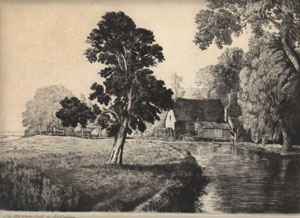 |
The Suffolk artist, Alfred Blundell pictured the old mill in one of his many drypoint scenes around the Breckland. From 1920 until 1968, Blundell lived at the nearby Tuddenham Mill. The River lark often featured in his work. A drypoint is produced by sketching on a steel plate with a sharp stylus. The raised burr produced by the stylus holds the ink when a print is taken from the plate. The resulting print looks like an etching but no acid has been used to remove unwanted areas, and so, has not been "etched" as such. During the Second World War water power was replaced by a diesel engine. In 1948 the mill was connected to the electricity National Grid. Electricity had arrived in the village in that year. The mill pool was later filled in to provide a car park. Marstons have continually extended and modernised this mill, so that it is on a completely different scale to the old mill, and water power has been long abandoned. In 1990 Marstons became part of Tate and Lyle, and all its flour production is now sent to Greenwich, where it is converted into glucose. The old watermill building survives in 2008 as the home of the dressing machines, separating meal from bran. A grandson of Carlos Marston remains as Mill Director. |
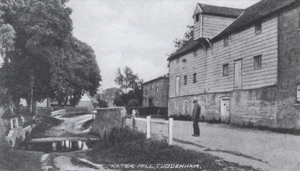 |
Tuddenham Mill This mill was mentioned in the Domesday Book, (28.3), as part of the holdings of Eudo the Steward, where a freeman called Canute held a manor. Tuddenham Mill stands on the Tuddenham millstream, which flows into the River Lark about a mile away. The mill is at the northern end of Tuddenham St Mary village, on a road which was once a main route from Norwich to London, via the Temple Bridge at Icklingham. The present mill was built in 1775, by Collins, millwrights of Melton. It had three pairs of millstones. By 1844 the mill had installed a steam engine for auxiliary power. In 1890 the Tuddenham Mill Stream had been dredged to allow navigation up to Tuddenham Mill. This work had required a new staunch to be installed on the mill stream. The millstream was made navigable as part of Lord Bristol's attempt to revive the Lark navigation, but the venture failed within a few years. In 1920 the artist Alfred Blundell took up residence, until his death in 1968. The mill worked until the 1950s. It was used for storage until 1973, when this mill was converted into a restaurant. The internal waterwheel has been retained. |
 |
Barton Mills Mill This small village was originally known as Little Barton, but to travellers it became known as Barton Mills. It stood on the main road to Norwich, where it crossed the River Lark. Originally there were two wheels operating seven pairs of stones. The wheels were 12ft by 8ft, and led travellers to remember the mills at Barton. Coaches to Brandon and Norwich could stop at the adjacent Bull Inn. The mill here was probably on a very old mill site, although it is not mentioned in the Domesday Book. By 1893 this mill had already been fitted with a steam engine, but had stood idle for some time. Parker Brothers decided they could do something with it. In 1894 William Howlett noted in the Bury Free Press that the fine old flour mill at Barton Mills had been hired by Parker Brothers of Mildenhall, and fully renovated. The old steam engine was put back into service, and the mill now converted to be a roller mill. This may be the beginnings of Parker Brothers move into flour milling. The River Lark Navigation and all its rights were finally sold to Parker Brothers of Mildenhall, on July 30th, 1902. This allowed them to use the river to service this mill, as well as Icklingham. This mill remained in production until the Second World War. The mill is now demolished, but the mill house remains. |
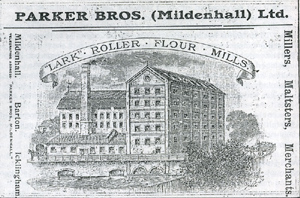 |
Mildenhall Mills - Lark Mill This mill is recorded in the Domesday Book, and dates back to before 1066. In 1722 there was a dispute between Mr Ralph at Mildenhall Mill, and Henry Ashley, the owner of the Navigation rights on the River Lark. Ralph seems to have had a string of grievances, but he was now threatening to pull up the Mildenhall Lower Staunch. He felt that he was not getting enough water to drive his mill. Ashley had avoided such disputes at Icklingham by buying the mill himself, and at Chimney Mills by taking on a long lease. Lark Mill had steam power introduced in 1868, and some time later the water wheel was replaced by water turbines. In 1887 the old wooden Lark mill was replaced by the large steam and water driven roller mill illustrated here. Roy Silverlock noted that it was reported as "the most important event in the locality", in Simpson's Retrospect for 1887. Simpson was a Mildenhall printer and publisher. By 1890 it was called the Lark Roller Mills, run by Mr Owers, who retired in 1897. In 1897 Lark Mills were taken over by Parker Brothers, who already kept the mill at Barton Mills, and would remain with that family until the late 20th century. In November, 1901 the expanding firm of Parker Brothers re-opened the Mildenhall Mill. The River Lark Navigation and all its rights were finally sold to Parker Brothers of Mildenhall, on July 30th, 1902. From 1919 to 1936 a dynamo driven by Parkers' mill supplied electricity to parts of Mildenhall.
In 1969 flour milling ceased at Lark Mills, and it went over to animal feedstuffs.
Silverlock notes that this mill had its grindstones powered by steam by 1870.
In 1921 the mill burnt down, by which date it was powered by a gas engine.
In 1922 the Bridge Mill was rebuilt powered by an oil engine. It continued as a feed mill until about 1970, when it became a furniture warehouse. It is now converted into flats.
|
|
A History of the Abbey of Bury St Edmunds, 1182-1256 by Antonia Gransden, 2007 Information first prepared by David Addy, 15th July 2008
|
| Go to Watermills Homepage | Go to River Lark Homepage |
Page created 15th July 2008 Last updated on 20th June 2016 | Go to Main Home Page |